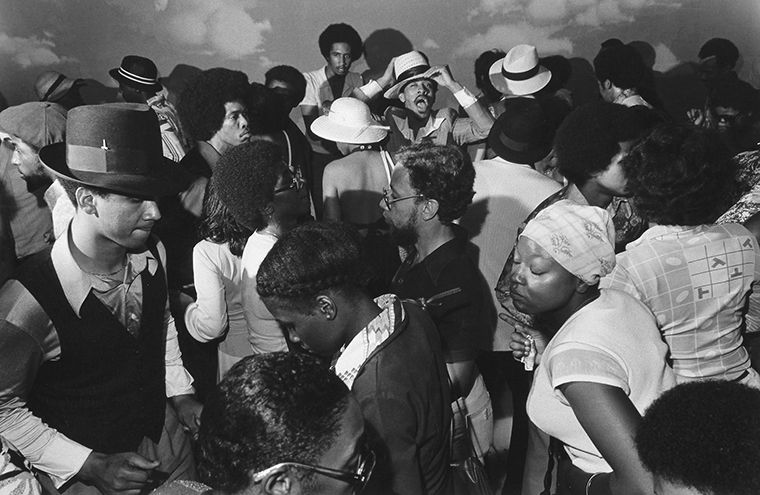‘Blues in Black and White’ shares colorful history
Perv’s House Lounge was one of the many blues clubs on Chicago’s South Side where photographer Michael L. Abramson would take photos of black night life in Chicago.
November 10, 2014
Michael L. Abramson’s photo series “Pulse of the Night,” which captures the feel and the look of the Chicago blues scene of the 1970s, was the topic of a Nov. 4 roundtable talk called “Blues in Black and White” at the Museum of Contemporary Photography, 600 S. Michigan Ave.
The roundtable consisted of Mark Pohlad, associate professor in the Department of History of Art and Architecture at DePaul University, David Grazian, associate professor of sociology at the University of Pennsylvania and Tom Lunt, producer of the “Light on the South Side: Photographs by Michael L. Abramson” box set. Moderated by Monica Hairston O’Connell, executive director of the Center for Black Music Research at Columbia, the three discussed the photographer’s work. Abramson, who died of kidney cancer in 2011 was best known for his commercial work and photographs of celebrities such as Steven Spielberg, Michael Jordan and Louis Farrakhan, which he took after he became a notable name in the photography industry.
His early career was spent photographing clubs on Chicago’s South Side while working on his master’s thesis at the Illinois Institute of Technology in the ‘70s. His work from the era will be on display at the museum through Dec. 19.
Pohlad said Abramson’s speciality was taking great portraits, no matter who his subject was.
“Photographing people was his thing,” Pohlad said. “No matter if it was at these clubs in the early days or CEOs later when he was a commercial photographer, he was always a great portraitist.”
Pohlad said before moving from New Jersey to Chicago to attend IIT, Abramson was not an expert photographer but was acutely aware of the social class differences that he later attempted to capture in his photos.
“As he started going to these clubs, he was also turning into a photographer,” Pohlad said. “He decided that this was going to be his life’s work.”
Grazian said Abramson was one of the few non-blacks to go to blues clubs on the South Side but was welcomed by the community.
“As documented in the photographs, these neighborhoods were predominantly African-American,” Grazian said. “Segregated from white neighborhoods in the city, the clubs would have predominantly black patrons in its audience, but there were occasionally white fans like Abramson that went to those clubs.”
Grazian said Abramson’s photographs show a scene in South Side blues clubs such as Pepper’s Lounge and Perv’s House, that is nothing like the atmosphere in those clubs today.
“The [sound] that one would hear in these South Side clubs was not the blues that one would hear in today’s clubs,” Grazian said. “It was sort of an amalgam of black styles of music, all sort of weaving together a kind of magical tapestry, funk, rhythm and blues, rock, gospel music, even disco. At these clubs, there was a much more inclusive way of thinking about the palette of African-American musical traditions.”
Lunt said he knew immediately that Abramson’s photographs had to be published because there was nothing else like them being done in the photography scene of that time.
“When I saw [these photographs], my first thought was, ‘These aren’t only interesting—they’re important,’” Lunt said. “Because I had been a long-time collector of photo books and studied photographers and photography for years and years, and so I knew what I was looking at.”
Lunt said Abramson’s work was unique because he captured the audience at these clubs, a concept no one else had previously published.
“Here’s a guy that did something really unusual,” Lunt said. “He went to these places and took photographs that nobody else took in these places. Everybody went down to the South Side and took a picture of Bobby Rush, took a picture of Buddy Guy—the cameras were always pointed at the stage and never at the people who were there.”
Pohlad said Abramson would shoot photos about five nights a week and take more than six rolls of photos each time as he got more involved with the South Side scene.
“In time, Abramson became a part of the scene he was photographing,” Pohlad said. “Patrons fed him, they lent him money, sometimes he said he got calls from clubs saying, ‘We’re having a party, are you going to be there on Saturday?’”
By photographing the audiences of the South Side blues clubs, Abramson was successful in capturing the culture of the clubs and the people who frequented them at the time, according to Lunt.
“When he did that, first you saw the accoutrement of a particular culture,” Lunt said. “The fashion, the flare, the way in which people interacted … nobody had ever done that before.”
“Pulse of the Night” is housed throughout the second floor of the Columbia Library, 624 S Michigan Ave., and will be on display through Dec. 19.








